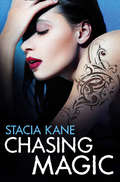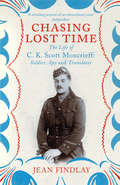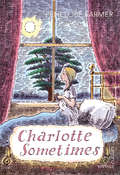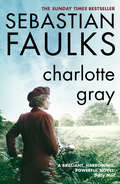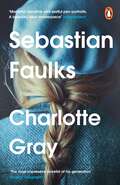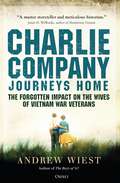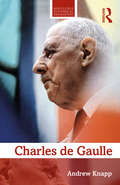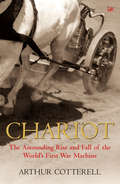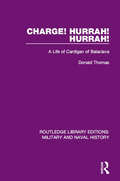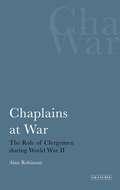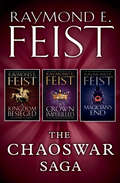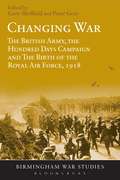- Table View
- List View
Chasing Magic (Downside Ghosts #5)
by Stacia KaneThe fifth book in Stacia Kane’s gripping and gritty DOWNSIDE GHOSTS urban fantasy series, perfect for fans of Charlaine Harris, Laurell K. Hamilton and Kim Harrison.
Chasing Lost Time: The Life of C.K. Scott Moncrieff: Soldier, Spy and Translator
by Jean FindlayC. K. Scott Moncrieff’s celebrated translation of Proust’s A La Recherche du Temps Perdu was first published in 1922 and was a work which would exhaust and consume the translator, leading to his early death at the age of just forty. Joseph Conrad told him, ‘I was more interested and fascinated by your rendering than by Proust’s creation’: some literary figures even felt it was an improvement on the original.From the outside an enigma, Scott Moncrieff left a trail of writings that describe a man expert at living a paradoxical life: fervent Catholic convert and homosexual, gregarious party-goer and deeply lonely, interwar spy in Mussolini’s Italy and public man of letters – a man for whom honour was the most abiding principle. He was a decorated war hero, and his letters home are an unusually light take on day-to-day life on the front. Described as ‘offensively brave’, he was severely injured in 1917 and, convalescing in London, became a lynchpin of literary society – friends with Robert Graves and Noel Coward, enemies with Siegfried Sassoon and in love with Wilfred Owen.Written by Scott Moncrieff’s great-great-niece, Jean Findlay, with exclusive access to the family archive, Chasing Lost Time is a portrait of a man hurled into war, through an era when the world was changing fast and forever, who brought us the greatest epic of time and memory that has ever been written.
Charlotte Sometimes (Red Fox Classics Ser.)
by Penelope Farmer'Suppose you got stuck in here, and Clare there in your time. Just suppose you did?’Charlotte Makepeace’s first day at boarding school is a bewildering blur of unfamiliar faces, timetables, rules and lists. All the other girls know the routine – and each other. No one invites her into their exclusive circles of whispers and giggles. But on Charlotte’s very first night something mysterious starts to happen. She wakes up in the same bed, in the same dormitory, in the same school. But something has changed. Somehow Charlotte has slipped forty years back in time...Includes exclusive material: In the Backstory you can learn what life was like during the First World WarVintage Children’s Classics is a twenty-first century classics list aimed at 8-12 year olds and the adults in their lives. Discover timeless favourites from The Jungle Book and Alice’s Adventures in Wonderland to modern classics such as The Boy in the Striped Pyjamas and The Curious Incident of the Dog in the Night-Time
Charlotte Gray: Wm Format (Ficción Internacional Ser.)
by Sebastian FaulksA remarkable story of a Scottish woman in Occupied France pursuing a perilous mission of her own FROM THE AUTHOR OF THE INTERNATIONAL BESTSELLER BIRDSONGIn 1942, Charlotte Gray, a young Scottish woman, heads for Occupied France on a dual mission - officially, to run an apparently simple errand for a British special operations group and unofficially, to search for her lover, an English airman missing in action. She travels to the village of Lavaurette, dyeing her hair and changing her name to conceal her identity. As the people in the small town prepare to meet their terrible destiny, Charlotte must come face-to-face with the harrowing truth of what took place in Europe’s darkest years, and confront a terrifying secret that threatens to cast its shadow over the remainder of her days. ‘There is no shortage of dramatic tension, excitement or persuasive detail... Faulks is a prodigiously talented writer’ New York Times----Also available by Sebastian Faulks as part of the French trilogy series: Girl at The Lion d’Or Birdsong
Charlotte Gray
by Sebastian Faulks'Excruciatingly powerful' ANTONY BEEVOR 'A brilliant, harrowing, powerful novel' DAILY MAIL 'Faulks is a prodigiously talented writer' NEW YORK TIMESIn the black of night, a woman lands on the fields of Occupied France. Charlotte Grey is on a mission for the British government to deliver a message and must shed her identity to blend into the small town of Lavaurette. But Charlotte has her own secret, her lover, airman Peter Gregory is missing in action, and she will risk everything to find him.A million-copy bestseller, Charlotte Gray is enthralling story of love, deceit and courage, and a classic of spy literature.
Charlie Company's Journey Home: The Forgotten Impact on the Wives of Vietnam Veterans
by Andrew WiestThe Boys of '67 and the War They Left BehindThe human experience of the Vietnam War is almost impossible to grasp – the camaraderie, the fear, the smell, the pain. Men were transformed into soldiers, and then into warriors.These warriors had wives who loved them and shared in their transformations. Some marriages were strengthened, while for others there was all too often a dark side, leaving men and their families emotionally and spiritually battered for years to come.Focusing in on just one company's experience of war and its eventual homecoming, Andrew Wiest shines a light on the shared experience of combat and both the darkness and resiliency of war's aftermath.
Charlie Company's Journey Home: The Forgotten Impact on the Wives of Vietnam Veterans
by Andrew WiestThe Boys of '67 and the War They Left BehindThe human experience of the Vietnam War is almost impossible to grasp – the camaraderie, the fear, the smell, the pain. Men were transformed into soldiers, and then into warriors.These warriors had wives who loved them and shared in their transformations. Some marriages were strengthened, while for others there was all too often a dark side, leaving men and their families emotionally and spiritually battered for years to come.Focusing in on just one company's experience of war and its eventual homecoming, Andrew Wiest shines a light on the shared experience of combat and both the darkness and resiliency of war's aftermath.
Charles de Gaulle (Routledge Historical Biographies)
by Andrew KnappIn this new biography, Andrew Knapp concisely dissects each of the major controversies surrounding General Charles de Gaulle, leader of the Free French during the Second World War and President of France from 1959 to 1969. From the beginning of de Gaulle’s military career in 1909 to an analysis of legacies and myths after his death in 1970, this study examines the path by which the French came to honour him as the greatest Frenchman of all time, and as the twentieth century’s pre-eminent world statesman. In each chapter, Knapp analyses de Gaulle’s participation in key events such as the development of France’s resistance against Nazi Germany, the decolonisation of Algeria, the birth of the French Fifth Republic, and the gigantic upheaval of May 1968. Simultaneously, this study questions de Gaulle’s actions and motives throughout his life. By exploring the justification of the contemporary ‘de Gaulle myth’, Knapp concludes by shedding new light on the influence of de Gaulle in the political culture of twenty-first-century France. Through careful analysis of primary sources as well as recent scholarship, this biography is an invaluable source for scholars and students of modern history, the history of France, political institutions, and international relations.
Charles de Gaulle (Routledge Historical Biographies)
by Andrew KnappIn this new biography, Andrew Knapp concisely dissects each of the major controversies surrounding General Charles de Gaulle, leader of the Free French during the Second World War and President of France from 1959 to 1969. From the beginning of de Gaulle’s military career in 1909 to an analysis of legacies and myths after his death in 1970, this study examines the path by which the French came to honour him as the greatest Frenchman of all time, and as the twentieth century’s pre-eminent world statesman. In each chapter, Knapp analyses de Gaulle’s participation in key events such as the development of France’s resistance against Nazi Germany, the decolonisation of Algeria, the birth of the French Fifth Republic, and the gigantic upheaval of May 1968. Simultaneously, this study questions de Gaulle’s actions and motives throughout his life. By exploring the justification of the contemporary ‘de Gaulle myth’, Knapp concludes by shedding new light on the influence of de Gaulle in the political culture of twenty-first-century France. Through careful analysis of primary sources as well as recent scholarship, this biography is an invaluable source for scholars and students of modern history, the history of France, political institutions, and international relations.
Charlemagne: Barbarian and Emperor
by Derek WilsonThe greatest of medieval monarchs, Charles the Great (742-814) towers over every notion we have of national heroes and semi-mythical champions. His military conquests exceeded those of Julius Caesar. He had the sagacity and dedication to public service of a Marcus Aurelius. In ruthlessness, as in dedication to personal culture, he was reminiscent of Augustus. But that is only the beginning. Charlemagne was a phenomenon and phenomena do not die. Later European leaders from Frederick Barbarossa and Charles V to Louis XIV, Napoleon I and Hitler took Charlemagne as their model. His growing mythology inspired the Crusades, fed the concept of chivalry, bolstered absolutist regimes, excited nineteenth-century liberals and emerges today among those who claim Charles the Great as the founder of European unity. Charlemagne is one of the most remarkable figures in European history: only by understanding him in all his complexity can we begin to understand Europe today. Derek Wilson's biography provides such an opportunity.
Chariot in Indian History
by U.P. ThapliyalThe invention and development of the chariot around the third millennium revolutionized the art of warfare and dominated the battlefields for some 3000 years. It seems to have evolved in the borderlands between the steppes and the riverlands. It is believed that the Āryan borrowed the idea of chariot from Sumerians around 2000 bc.It is presumed that these Āryans entered Iran and departed in three branches. One marches westward towards Syria, another eastward towards India and a third stays back in Iran. The absence of chariot in Indus valley civilization suggests that chariot arrived in India with Āryans, who settled here around 1500 bc. They used it as a lethal war machine to conquer the natives. The Chariot has played a vital role in Indian warfare through the ages, spanning over Vedic, Epic, and Puranic times, as attested to by literary and archaeological evidence. The Turk invasion marked by the dominance of cavalry arm brought the curtain down on chariot as a war machine. However, it survived in the Indian milieu in some other incarnations.
Chariot in Indian History
by U.P. ThapliyalThe invention and development of the chariot around the third millennium revolutionized the art of warfare and dominated the battlefields for some 3000 years. It seems to have evolved in the borderlands between the steppes and the riverlands. It is believed that the Āryan borrowed the idea of chariot from Sumerians around 2000 bc.It is presumed that these Āryans entered Iran and departed in three branches. One marches westward towards Syria, another eastward towards India and a third stays back in Iran. The absence of chariot in Indus valley civilization suggests that chariot arrived in India with Āryans, who settled here around 1500 bc. They used it as a lethal war machine to conquer the natives. The Chariot has played a vital role in Indian warfare through the ages, spanning over Vedic, Epic, and Puranic times, as attested to by literary and archaeological evidence. The Turk invasion marked by the dominance of cavalry arm brought the curtain down on chariot as a war machine. However, it survived in the Indian milieu in some other incarnations.
Chariot: The Astounding Rise and Fall of the World's First War Machine
by Arthur CotterellThe chariot changed the face of ancient warfare. First in West Asia and Egypt, then in India and China, charioteers came to dominate the battlefield. Its use as a war machine is graphically recounted in Indian epics and Chinese chronicles. Homer's Iliad tells of the attack on Troy by Greek heroes who rode in chariots. In 326 BC Alexander the Great faced charioteers in northern India, while in 55 BC, on a Kent beach, Julius Caesar was met by British chariots. Because of the danger involved, chariot racing attracted hundreds of thousands of spectators. So enthusiastic were they that the Roman emperor Nero could not resist driving his own ten-horse chariot at the Olympic Games: he fell out but still won the prize. Rivalry between groups of spectators at chariot races often ignited urban riots. In Constantinople, in 532 AD, a three-day disturbance left 30,000 dead.
Charge! Hurrah! Hurrah!: A Life of Cardigan of Balaclava (Routledge Library Editions: Military and Naval History)
by Donald ThomasFor James Thomas Brudenell, 7th Earl of Cardigan, leading the Light Brigade at Balaclava was but one incident in a life of sensation and notoriety. Donald Thomas’s biography, originally published in 1977, and based on new material when originally published, shows this most controversial Victorian against a panorama of regimental intrigue and aristocratic luxury. Dismissed from the army for ‘revolting’ conduct, Cardigan bought the command of the 11th Hussars (the ‘Cherry Bums’) for £40,000 a few years later. Regimental rivalries led to the ‘Black Bottle’ scandal of 1840 and to a duel in which he shot a brother officer. Charged with attempted murder, Cardigan was the only Victorian peer to be tried by the House of Lords. Nonetheless, his seductions of other men’s wives rivalled his regimental misdemeanours in press reports. He was jeered int he streets, hissed at the theatre and burnt in effigy. It took the glory and the folly of Balaclava to turn ‘this plague-spot of the British army’ into ‘the most popular soldier in England’. Greeted everywhere by cheering crowds, their new hero fought duels and libel actions against those who denied his bravery before the Russian guns. For all his misbehaviour, Cardigan remains warm-blooded, generous, impulsive and courageous, as well as obstinate, proud and sometimes ridiculous. Hated by numerous men, and adored by many women, his elopement with the beautiful Adeline Horsey de Horsey was a triumph of his old age.
Charge! Hurrah! Hurrah!: A Life of Cardigan of Balaclava (Routledge Library Editions: Military and Naval History)
by Donald ThomasFor James Thomas Brudenell, 7th Earl of Cardigan, leading the Light Brigade at Balaclava was but one incident in a life of sensation and notoriety. Donald Thomas’s biography, originally published in 1977, and based on new material when originally published, shows this most controversial Victorian against a panorama of regimental intrigue and aristocratic luxury. Dismissed from the army for ‘revolting’ conduct, Cardigan bought the command of the 11th Hussars (the ‘Cherry Bums’) for £40,000 a few years later. Regimental rivalries led to the ‘Black Bottle’ scandal of 1840 and to a duel in which he shot a brother officer. Charged with attempted murder, Cardigan was the only Victorian peer to be tried by the House of Lords. Nonetheless, his seductions of other men’s wives rivalled his regimental misdemeanours in press reports. He was jeered int he streets, hissed at the theatre and burnt in effigy. It took the glory and the folly of Balaclava to turn ‘this plague-spot of the British army’ into ‘the most popular soldier in England’. Greeted everywhere by cheering crowds, their new hero fought duels and libel actions against those who denied his bravery before the Russian guns. For all his misbehaviour, Cardigan remains warm-blooded, generous, impulsive and courageous, as well as obstinate, proud and sometimes ridiculous. Hated by numerous men, and adored by many women, his elopement with the beautiful Adeline Horsey de Horsey was a triumph of his old age.
Chaplains at War: The Role of Clergymen During World War II (International Library of War Studies)
by Alan RobinsonPatriotism and religious belief were defining characteristics of both public and private life during the 20th century. British army chaplains were shaped by these powerful sentiments and in turn shaped and interpreted them to understand their own roles and to provide a message and ministry to soldiers and officers. Focusing on World War II,. 'Chaplains at War' reveals how the army, the government and the churches responded to the challenges of war, leading to innovation that was unknown in peace time such as the appointing women as Chaplains' Assistants. Alan Robinson uses interviews with former chaplains, officers and soldiers and extensive archive research in military, government and church archives to draw together personal experience and official policy. His book will be essential reading for anyone interested in British military history, church history and religious studies.
The Chaoswar Saga: A Kingdom Besieged; A Crown Imperilled; Magician's End
by Raymond E. FeistReturn to a world of magic and adventure from bestselling author Raymond E. Feist. This bundle includes the complete Chaoswar Saga. The bundle includes: A Kingdom Besieged, A Crown Imperilled, Magician’s End.
Channels of Power: The UN Security Council and U.S. Statecraft in Iraq
by Alexander ThompsonWhen President George W. Bush launched an invasion of Iraq in March of 2003, he did so without the explicit approval of the Security Council. His father's administration, by contrast, carefully funneled statecraft through the United Nations and achieved Council authorization for the U.S.-led Gulf War in 1991. The history of American policy toward Iraq displays considerable variation in the extent to which policies were conducted through the UN and other international organizations.In Channels of Power, Alexander Thompson surveys U.S. policy toward Iraq, starting with the Gulf War, continuing through the interwar years of sanctions and coercive disarmament, and concluding with the 2003 invasion and its long aftermath. He offers a framework for understanding why powerful states often work through international organizations when conducting coercive policies-and why they sometimes choose instead to work alone or with ad hoc coalitions. The conventional wisdom holds that because having legitimacy for their actions is important for normative reasons, states seek multilateral approval. Channels of Power offers a rationalist alternative to these standard legitimation arguments, one based on the notion of strategic information transmission: When state actions are endorsed by an independent organization, this sends politically crucial information to the world community, both leaders and their publics, and results in greater international support.
The Channel Islands 1941–45: Hitler's impregnable fortress (Fortress)
by Chris Taylor Charles StephensonFollowing the fall of France and the surrender of Paris on 14 June 1940, the British Government announced that the Channel Islands had no strategic importance and would not be defended. The Germans occupied the islands from the end of June onwards and remained in control until the end of the war. On 10 October 1941 Hitler announced his intention to 'convert them into an impregnable fortress', and the islands formed the most heavily fortified and defended section of the entire Atlantic Wall. This book describes the design, construction and manning of these defensive positions, as well as considering more widely the occupation of the Channel Islands by the Germans.
The Channel Islands 1941–45: Hitler's impregnable fortress (Fortress #41)
by Chris Taylor Charles StephensonFollowing the fall of France and the surrender of Paris on 14 June 1940, the British Government announced that the Channel Islands had no strategic importance and would not be defended. The Germans occupied the islands from the end of June onwards and remained in control until the end of the war. On 10 October 1941 Hitler announced his intention to 'convert them into an impregnable fortress', and the islands formed the most heavily fortified and defended section of the entire Atlantic Wall. This book describes the design, construction and manning of these defensive positions, as well as considering more widely the occupation of the Channel Islands by the Germans.
Changing War: The British Army, the Hundred Days Campaign and The Birth of the Royal Air Force, 1918 (Birmingham War Studies)
by Gary Sheffield Peter GrayIn 1918, the British Expeditionary Force (BEF) played a critical role in defeating the German army and thus winning the First World War. This 'Hundred Days' campaign (August to November 1918) was the greatest series of land victories in British military history. 1918 also saw the creation of the Royal Air Force, the world's first independent air service, from the Royal Flying Corps and the Royal Naval Air Service. Until recently, British histories of the First World War have tended to concentrate on the earlier battles of 1916 and 1917 and often underplayed this vitally important period.Changing War fills this significant gap in our knowledge by providing in-depth examinations of key aspects of the operations of the British Army, the Royal Air Force and its antecedents in the climactic year of the First World War. Written by a group of established historians and emerging scholars it sheds light not only on 1918, but on the revolutionary changes in warfare that took place at that time.
Changing War: The British Army, the Hundred Days Campaign and The Birth of the Royal Air Force, 1918 (Birmingham War Studies #6)
by Gary Sheffield Peter GrayIn 1918, the British Expeditionary Force (BEF) played a critical role in defeating the German army and thus winning the First World War. This 'Hundred Days' campaign (August to November 1918) was the greatest series of land victories in British military history. 1918 also saw the creation of the Royal Air Force, the world's first independent air service, from the Royal Flying Corps and the Royal Naval Air Service. Until recently, British histories of the First World War have tended to concentrate on the earlier battles of 1916 and 1917 and often underplayed this vitally important period.Changing War fills this significant gap in our knowledge by providing in-depth examinations of key aspects of the operations of the British Army, the Royal Air Force and its antecedents in the climactic year of the First World War. Written by a group of established historians and emerging scholars it sheds light not only on 1918, but on the revolutionary changes in warfare that took place at that time.
Changing the Narrative: Information Campaigns, Strategy and Crisis Escalation in the Digital Age (Adelphi series)
by Lawrence Freedman Heather WilliamsNarratives provide the storylines of conflict and in doing so become an arena of conflict themselves. When states mount information campaigns against each other, they are trying to change the narrative. The digital platforms of the new information environment have been identified by various analysts as a significant factor in contemporary strategy and crisis management. But while social media is noisier and more chaotic than traditional media, and unprecedented in its immediacy and accessibility, has it thus far been a game changer in strategic affairs? In this Adelphi book, Sir Lawrence Freedman and Heather Williams examine the impact of state-led digital information – or disinformation – campaigns in four contexts: the India–Pakistan crisis over Kashmir in 2019; the heightened tensions between the United States and Iran following the assassination of Qasem Soleimani in 2020; China’s messaging in response to the COVID-19 pandemic from 2020–22; and the Russia–Ukraine crisis from 2013–23. While noting the meaningful consequences of digital information campaigns, in each case the authors call for a sense of perspective. Such campaigns are only one aspect of wider political struggles. They are also difficult for their initiators to control, and less likely to influence foreign audiences than domestic ones. Overall, the authors argue, there is little evidence so far to suggest such campaigns will have as much influence over contemporary crises as the classical instruments of military and economic power.
Changing the Narrative: Information Campaigns, Strategy and Crisis Escalation in the Digital Age (Adelphi series)
by Lawrence Freedman Heather WilliamsNarratives provide the storylines of conflict and in doing so become an arena of conflict themselves. When states mount information campaigns against each other, they are trying to change the narrative. The digital platforms of the new information environment have been identified by various analysts as a significant factor in contemporary strategy and crisis management. But while social media is noisier and more chaotic than traditional media, and unprecedented in its immediacy and accessibility, has it thus far been a game changer in strategic affairs? In this Adelphi book, Sir Lawrence Freedman and Heather Williams examine the impact of state-led digital information – or disinformation – campaigns in four contexts: the India–Pakistan crisis over Kashmir in 2019; the heightened tensions between the United States and Iran following the assassination of Qasem Soleimani in 2020; China’s messaging in response to the COVID-19 pandemic from 2020–22; and the Russia–Ukraine crisis from 2013–23. While noting the meaningful consequences of digital information campaigns, in each case the authors call for a sense of perspective. Such campaigns are only one aspect of wider political struggles. They are also difficult for their initiators to control, and less likely to influence foreign audiences than domestic ones. Overall, the authors argue, there is little evidence so far to suggest such campaigns will have as much influence over contemporary crises as the classical instruments of military and economic power.
Changing the Conditions for Development Aid: A New Paradigm?
by Neils Hermes Robert LensinkIn 1998 the World Bank published a report entitled "Assessing Aid: What Works, What Doesn't and Why". This report presents the results of an extensive investigation into the effectiveness of development aid. The main message of the text of the report is that development aid helps, but only when there is a good policy environment in the recipient countries, that is when there is sound macroeconomic management and when robust government institutions exist. It stresses that it is a myth to think that good policies can be bought by giving development aid: giving aid conditional on policy reforms does not lead to improved economic policies. The conclusion of the World Bank report is that aid flows should be directed only to countries with sound policies and that it should be focused more on supporting governments in reforming entire sectors, rather than on specific development projects. The "Assessing Aid" report has led to heated debates, both among academics and policy-makers, about development aid and aid policies. Many have questioned the methodology used, the results and the policy conclusions of the report. This book aims to contribute to the ongoing discussion about the future of development aid. In particular, it re-examines a number of issues that are crucial to the analysis and to the conclusions of the World Bank report. In this study the authors aim to put the discussion on the future of development aid into perspective and summarise the main findings of the other studies in this collection. They focus on two issues: the aid effectiveness debate before and after the Assessing Aid report, and the discussion on policy conditionality and good governance. Section II provides a brief survey of past research on aid effectiveness, that is, before publication of the Assessing Aid report and summarises the main findings of the World Bank report on aid effectiveness. In this study the authors aim to put the discussion on the future of development aid into perspective and summarise the main findings of the other studies in this collection. They focus on two issues: the aid effectiveness debate before and after the Assessing Aid report, and the discussion on policy conditionality and good governance. Section II provides a brief survey of past research on aid effectiveness, that is, before publication of the Assessing Aid report and summarises the main findings of the World Bank report on aid effectiveness.
